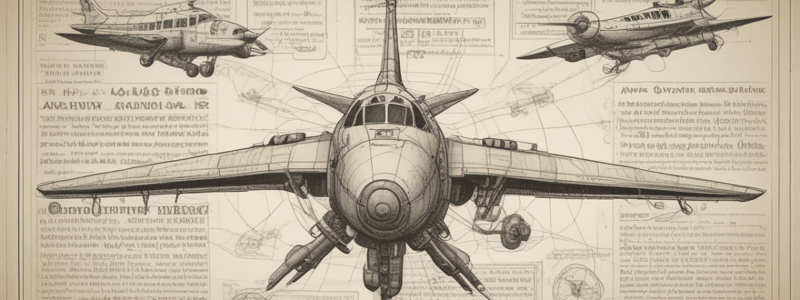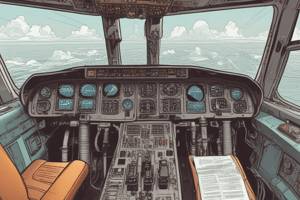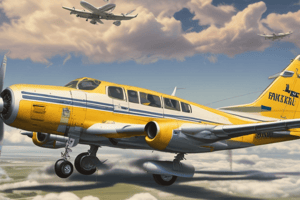Podcast
Questions and Answers
What is the primary goal of conducting regular inspections on an aircraft?
What is the primary goal of conducting regular inspections on an aircraft?
- To detect and rectify any potential issues before they compromise safety (correct)
- To identify Pilot Error
- To documentation and record-keeping involved
- To ensure Pilots are well-versed in FAA regulations
What document provides guidelines for determining if an aircraft can safely be operated without certain equipment?
What document provides guidelines for determining if an aircraft can safely be operated without certain equipment?
- FAA Regulations
- MEL (Minimum Equipment List) (correct)
- Airworthiness Certificate
- Pilot's Operating Handbook
When is an item classified as inoperative but deferrable?
When is an item classified as inoperative but deferrable?
- When the Pilot decides it is not necessary
- When it is not required for safe flight as per the MEL (correct)
- When it is required for safe flight as per the MEL
- When the maintenance crew decides it is not necessary
Why is it important for Pilots and maintenance crews to possess a comprehensive understanding of their respective roles?
Why is it important for Pilots and maintenance crews to possess a comprehensive understanding of their respective roles?
What is the purpose of pre-flight checks performed by the pilot?
What is the purpose of pre-flight checks performed by the pilot?
What is a critical component of ensuring safety in flight operations?
What is a critical component of ensuring safety in flight operations?
Who is responsible for making the decision to classify an item as inoperative but deferrable?
Who is responsible for making the decision to classify an item as inoperative but deferrable?
What is the result of mastery of safety procedures and regulations in flight operations?
What is the result of mastery of safety procedures and regulations in flight operations?
What is the significance of the Minimum Equipment List (MEL)?
What is the significance of the Minimum Equipment List (MEL)?
What is the overall purpose of safety procedures in flight operations?
What is the overall purpose of safety procedures in flight operations?
The Minimum Equipment List is a document that outlines emergency protocols for pilots.
The Minimum Equipment List is a document that outlines emergency protocols for pilots.
Pilots are responsible for carrying out annual inspections on aircraft.
Pilots are responsible for carrying out annual inspections on aircraft.
Inoperative equipment must always be repaired immediately before flight.
Inoperative equipment must always be repaired immediately before flight.
Pilots are not required to understand documentation and record-keeping involved in inspections.
Pilots are not required to understand documentation and record-keeping involved in inspections.
Safety procedures in flight operations are primarily the responsibility of maintenance crews.
Safety procedures in flight operations are primarily the responsibility of maintenance crews.
The FAA regulations regarding inoperative equipment are flexible and allow for personal interpretation.
The FAA regulations regarding inoperative equipment are flexible and allow for personal interpretation.
Inspections are only necessary for commercial aircraft.
Inspections are only necessary for commercial aircraft.
Pilots and maintenance crews only need to understand their individual roles in safety procedures.
Pilots and maintenance crews only need to understand their individual roles in safety procedures.
Inoperative equipment is always a safety hazard.
Inoperative equipment is always a safety hazard.
Pre-flight checks are only necessary for long-haul flights.
Pre-flight checks are only necessary for long-haul flights.
What is the primary objective of integrating predefined emergency protocols, thorough inspection routines, and clear regulations on equipment operability in flight operations?
What is the primary objective of integrating predefined emergency protocols, thorough inspection routines, and clear regulations on equipment operability in flight operations?
How do FAA regulations regarding inoperative equipment influence the decision-making process when a component is not functioning as intended?
How do FAA regulations regarding inoperative equipment influence the decision-making process when a component is not functioning as intended?
What is the significance of consultation between pilots and maintenance personnel in determining whether an item is inoperative but deferrable?
What is the significance of consultation between pilots and maintenance personnel in determining whether an item is inoperative but deferrable?
How do pilots and maintenance crews contribute to the overall safety of aviation operations worldwide?
How do pilots and maintenance crews contribute to the overall safety of aviation operations worldwide?
What is the relationship between the complexity of safety procedures and the requirement for pilots and maintenance crews to possess a comprehensive understanding of their roles?
What is the relationship between the complexity of safety procedures and the requirement for pilots and maintenance crews to possess a comprehensive understanding of their roles?
How do the responsibilities of pilots and maintenance crews intersect in the context of safety procedures?
How do the responsibilities of pilots and maintenance crews intersect in the context of safety procedures?
What is the consequence of inadequate understanding of safety procedures and regulations among pilots and maintenance crews?
What is the consequence of inadequate understanding of safety procedures and regulations among pilots and maintenance crews?
How do the criteria for determining if an item is inoperative but deferrable influence the decision-making process?
How do the criteria for determining if an item is inoperative but deferrable influence the decision-making process?
What is the significance of documentation and record-keeping in the context of inspections and safety procedures?
What is the significance of documentation and record-keeping in the context of inspections and safety procedures?
How do the roles of pilots and maintenance crews intersect in the context of ensuring compliance with safety standards?
How do the roles of pilots and maintenance crews intersect in the context of ensuring compliance with safety standards?
Flashcards are hidden until you start studying
Study Notes
Aircraft Equipment Regulations
- The Flight Manual is a crucial document that guides pilots in safe flight operations, mitigating risks and handling uncertainties through its outlined procedures and performance metrics.
Emergency Procedures
- The Emergency Procedures section in the Flight Manual provides step-by-step instructions for specific emergencies, such as engine failures and electrical issues.
- Mastering these protocols empowers pilots to decisively navigate through anomalies and unexpected situations.
- The section is born from rigorous analysis and real-world mishaps, designed to inform pilots on how to handle critical situations.
Performance Section
- The Performance section in the Flight Manual informs pilots of vital parameters such as take-off and landing distances, fuel consumption, and speed profiles.
- This data-rich segment enables pilots to tailor every flight to the unique dance of weight, weather, and wind.
- It fosters a proactive approach to flight planning, ensuring pilots adhere to parameters required for a safe flight.
Maintenance and Safety
- Maintenance is critical in reducing the risk of in-flight failures and accidents.
- Scheduled check-ups and inspections catch small issues before they become big problems.
- Proper log entries verify completed jobs and create a paper trail that regulators or future mechanics can follow with absolute certainty.
Safety Management System (SMS)
- An SMS is designed as an organizational safety net, where maintenance functions as a core component, ensuring every takeoff is as safe as the last.
- Neglecting maintenance is a critical failure in the SMS, leading to significant consequences that span far beyond compliance issues.
Implementing Safety Procedures
- Safety procedures in flight operations are derived from three primary sources: the Emergency Procedures section in the Flight Manual, inspection requirements as outlined by 14 CFR part 91, and the FAA regulations regarding inoperative equipment.
- Familiarity with the Emergency Procedures section is critical for pilots, as it provides a structured response to various in-flight emergencies.
- Inspection requirements under 14 CFR part 91 ensure that all aspects of an aircraft are functioning correctly and safely.
- FAA regulations regarding inoperative equipment dictate how to handle situations when a component is not functioning as intended.
Aircraft Equipment Regulations
- The Flight Manual is a pivotal document for pilots, providing guidance on emergency procedures and performance metrics to ensure safe flight operations.
- The Emergency Procedures section of the Flight Manual provides step-by-step instructions for specific emergencies, such as engine failures and electrical issues.
- These procedures are designed to empower pilots to decisively navigate through anomalies and are born from rigorous analysis and real-world mishaps.
The Importance of Maintenance
- Maintenance is an essential pillar of aviation safety, ensuring that aircraft meet and exceed safety standards through diligent application of regulations, understanding of equipment, and depth of knowledge.
- According to 14 CFR Part 91, every aircraft owner and operator has a legal obligation to maintain their aircraft in an airworthy state.
- Regular maintenance significantly reduces the risk of in-flight failures and accidents.
Maintenance Requirements
- Maintenance requirements include regular inspections, timely repairs, necessary replacements, and accurate record-keeping.
- The eagle-eyed attention of aircraft technicians during scheduled check-ups prevents the majority of in-flight failures and accidents.
- Proper log entries verify completed jobs and create a paper trail that regulators or future mechanics can follow with absolute certainty.
The Role of the Safety Management System (SMS)
- The SMS is designed as an organizational safety net, with maintenance functioning as a core component.
- The SMS builds a culture where safety isn't a choice; it's a requirement.
- Neglecting maintenance is a critical failure in the SMS.
Operational Safety Procedures
- The implementation of safety procedures during flight operations is derived from three primary sources: the Emergency Procedures section in the Flight Manual, inspection requirements as outlined by 14 CFR part 91, and the FAA regulations regarding inoperative equipment.
- The Emergency Procedures section provides a structured response to various in-flight emergencies, such as engine failures, electrical malfunctions, and in-flight fires.
- Inspection requirements under 14 CFR part 91 form the backbone of aircraft maintenance and safety.
- The FAA regulations regarding inoperative equipment dictate how to handle situations when a component is not functioning as intended.
Aircraft Equipment Regulations: Flight Manual and Maintenance
- The Flight Manual is a crucial document for pilots, providing meticulous procedures and performance metrics to mitigate risks and handle uncertainties.
Emergency Procedures Section
- The Emergency Procedures section is a critical resource for pilots, offering step-by-step instructions for specific emergencies, such as engine failures and electrical issues.
- These procedures are designed to empower pilots to decisively navigate through anomalies and are born from rigorous analysis and real-world mishaps.
Performance Section
- The Performance section is a data-rich segment that informs pilots of vital parameters, including take-off and landing distances, fuel consumption, and speed profiles.
- This section enables pilots to tailor every flight to unique conditions, such as weight, weather, and wind, ensuring safe and efficient flight planning.
Maintenance Impact on Flight Safety
- According to 14 CFR Part 91, every aircraft owner and operator has a legal obligation to maintain their aircraft in an airworthy state.
- Regular inspections, timely repairs, necessary replacements, and accurate record-keeping are essential to ensure the airworthiness of an aircraft.
Importance of Maintenance
- Maintenance is a critical component of aviation safety, ensuring every takeoff is as safe as the last.
- It builds a culture where safety isn't a choice; it's a requirement.
Operational Safety Procedures
- The implementation of safety procedures during flight operations is derived from three primary sources: the Emergency Procedures section in the Flight Manual, inspection requirements as outlined by 14 CFR part 91, and the FAA regulations regarding inoperative equipment.
- Familiarity with the Emergency Procedures section is a critical aspect of a pilot's training and ongoing proficiency checks.
- Inspection requirements under 14 CFR part 91 form the backbone of aircraft maintenance and safety, and pilots must be well-versed in these requirements.
Studying That Suits You
Use AI to generate personalized quizzes and flashcards to suit your learning preferences.




